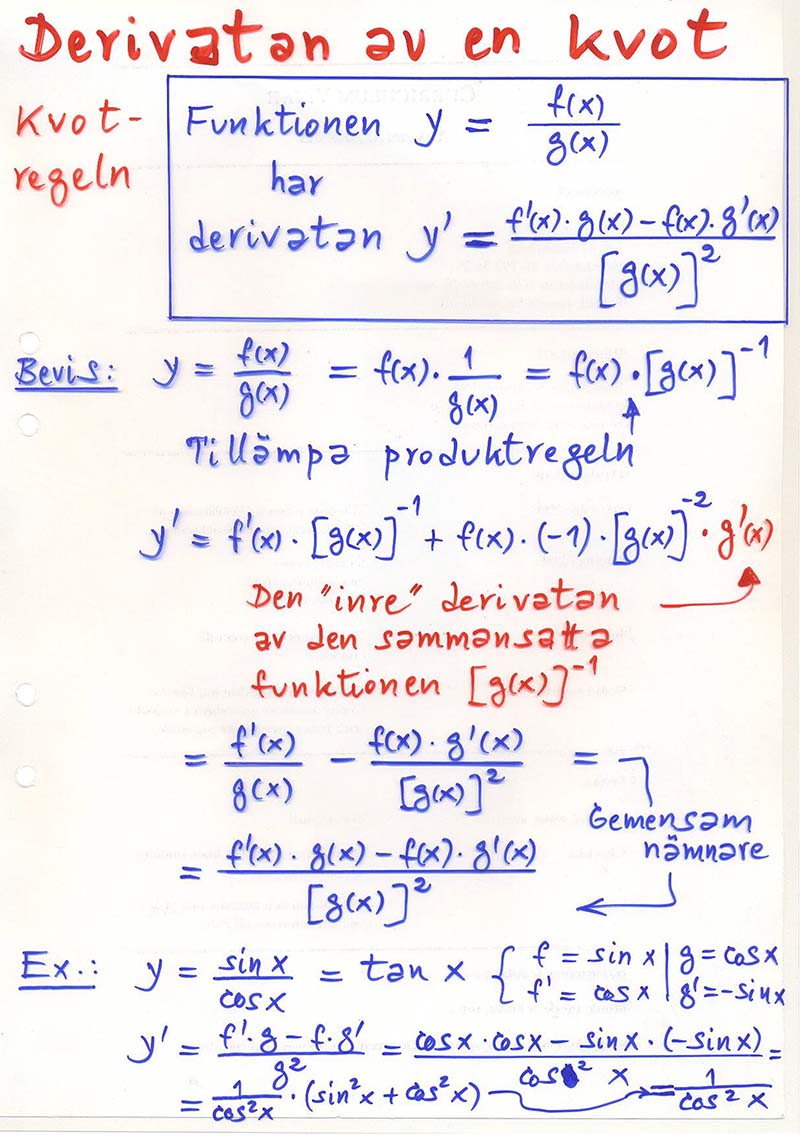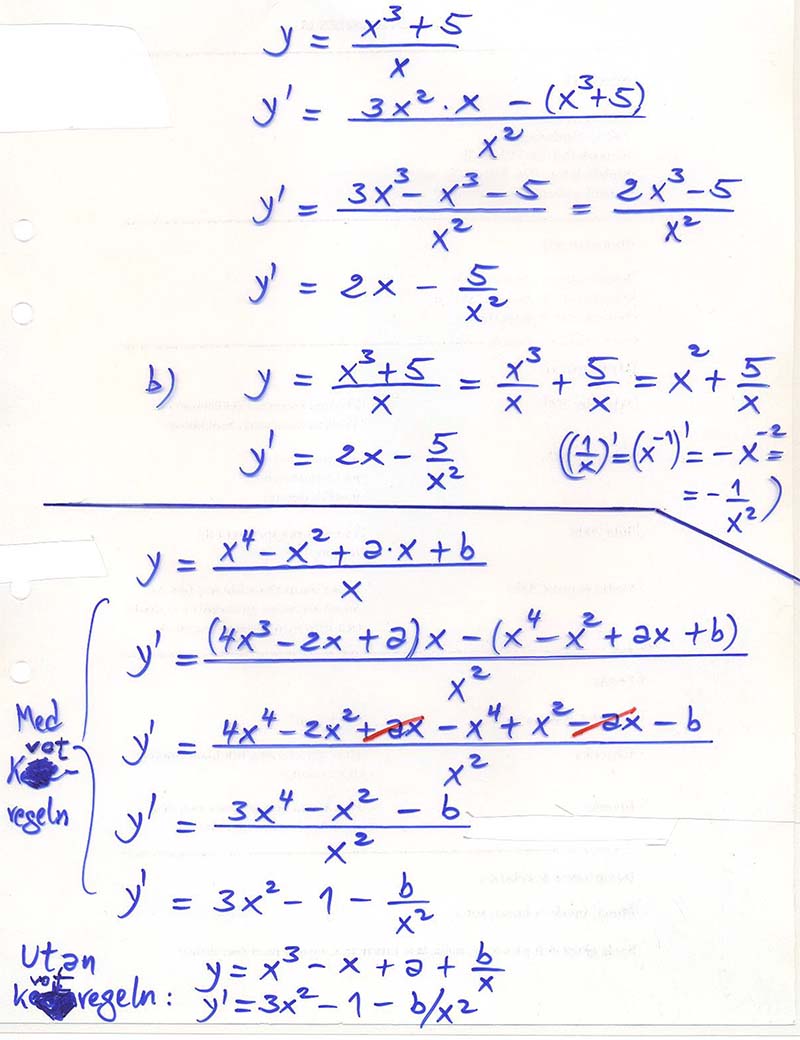Skillnad mellan versioner av "2.5 Derivatan av en kvot: Kvotregeln"
Från Mathonline
Taifun (Diskussion | bidrag) m |
Taifun (Diskussion | bidrag) m |
||
| Rad 12: | Rad 12: | ||
= <b><span style="color:#931136">Deriveringsregler uppdaterade med produktregeln</span></b> = | = <b><span style="color:#931136">Deriveringsregler uppdaterade med produktregeln</span></b> = | ||
| + | = <b><span style="color:#931136">Deriveringsregler</span></b> = | ||
| + | <big><big>I följande tabeller är <math> C,\,c,\,k,\,m,\,n,\,a > 0 </math> konstanter medan <math> \boldsymbol{x}\, </math>, <math> \boldsymbol{y}\, </math> är variabler och <math> \boldsymbol{y = f(x)}</math>.</big></big> | ||
| + | <table><tr><td> | ||
| + | <div class="border-divblue"> | ||
| + | {| class="wikitable" | ||
| + | |- | ||
| + | ! <math> \boldsymbol{y}\, </math> || <math> \boldsymbol{y\,'} </math> | ||
| + | |- | ||
| + | | align=center| <math> c\, </math> ||align=center| <math> 0\, </math> | ||
| + | |- | ||
| + | | align=center| <math> x\, </math> ||align=center| <math> 1\, </math> | ||
| + | |- | ||
| + | | align=center| <math> a\; x </math> ||align=center| <math> a\, </math> | ||
| + | |- | ||
| + | | align=center| <math> k\; x \, + \, m </math> ||align=center| <math> k\, </math> | ||
| + | |- | ||
| + | | align=center| <math> x^2\, </math> ||align=center| <math> 2\,x </math> | ||
| + | |- | ||
| + | | align=center| <math> a\,x^2 </math> ||align=center| <math> 2\,a\,x </math> | ||
| + | |- | ||
| + | | align=center| <math> x^n\, </math> ||align=center| <math> n\cdot x\,^{n-1} </math> | ||
| + | |- | ||
| + | | align=center| <math> a\,x\,^n </math> ||align=center| <math> a\cdot n\cdot x\,^{n-1} </math> | ||
| + | |- | ||
| + | | align=center| <math> 1 \, / \, x </math> ||align=center| <math> - 1 \, / \, x^2 </math> | ||
| + | |- | ||
| + | | align=center| <math> \sqrt{x} </math> ||align=center| <math> 1 \, / \, 2\, \sqrt{x} </math> | ||
| + | |} | ||
| + | </div> | ||
| + | </td> | ||
| + | <td> </td> | ||
| + | <td> | ||
| + | <div class="border-divblue"> | ||
| + | {| class="wikitable" | ||
| + | |- | ||
| + | ! <math> \boldsymbol{y}\, </math> || <math> \boldsymbol{y\,'} </math> | ||
| + | |- | ||
| + | | align=center| <math> e\,^x </math> ||align=center| <math> e\,^x </math> | ||
| + | |- | ||
| + | | align=center| <math> e\,^{k\,x} </math> ||align=center| <math> k\cdot e\,^{k\,x} </math> | ||
| + | |- | ||
| + | | align=center| <math> C\cdot e\,^{k\,x} </math> ||align=center| <math> C\cdot k\cdot e\,^{k\,x} </math> | ||
| + | |- | ||
| + | | align=center| <math> a\,^x </math> ||align=center| <math> a\,^x \cdot \ln a </math> | ||
| + | |- | ||
| + | | align=center| <math> C\cdot a\,^{k\,x} </math> ||align=center| <math> \quad C\cdot k\cdot a\,^{k\,x} \cdot \ln a \quad </math> | ||
| + | |- | ||
| + | | align=center| <math> \sin x </math> ||align=center| <math> \cos x </math> | ||
| + | |- | ||
| + | | align=center| <math> \cos x </math> ||align=center| <math> - \sin x </math> | ||
| + | |- | ||
| + | | align=center| <math> f(g(x)) </math> ||align=center| <math> f\,'(g(x)) \cdot g\,'(x) </math> | ||
| + | |- | ||
| + | | align=center| <math> a\cdot f(x) </math> ||align=center| <math> a\cdot f\,'(x) </math> | ||
| + | |- | ||
| + | | align=center| <math> f(x) + g(x)\, </math> ||align=center| <math> f\,'(x) + g\,'(x) </math> | ||
| + | |} | ||
| + | </div> | ||
| + | </td> | ||
| + | </tr> | ||
| + | </table> | ||
<big> | <big> | ||
I följande tabell är <math> C,\,c,\,k,\,m,\,n,\,a > 0 </math> konstanter medan <math> \boldsymbol{x}\, </math> och <math> \boldsymbol{y}\, </math> är variabler: | I följande tabell är <math> C,\,c,\,k,\,m,\,n,\,a > 0 </math> konstanter medan <math> \boldsymbol{x}\, </math> och <math> \boldsymbol{y}\, </math> är variabler: | ||
Versionen från 20 november 2024 kl. 11.19
| << Förra avsnitt | Genomgång | Övningar | Facit | Nästa avsnitt >> |
Deriveringsregler uppdaterade med produktregeln
Deriveringsregler
I följande tabeller är \( C,\,c,\,k,\,m,\,n,\,a > 0 \) konstanter medan \( \boldsymbol{x}\, \), \( \boldsymbol{y}\, \) är variabler och \( \boldsymbol{y = f(x)}\).
|
|
I följande tabell är \( C,\,c,\,k,\,m,\,n,\,a > 0 \) konstanter medan \( \boldsymbol{x}\, \) och \( \boldsymbol{y}\, \) är variabler:
| \( \boldsymbol{y}\, \) | \( \boldsymbol{y\,'} \) |
|---|---|
| \( c\, \) | \( 0\, \) |
| \( x\, \) | \( 1\, \) |
| \( a\; x \) | \( a\, \) |
| \( k\; x \, + \, m \) | \( k\, \) |
| \( x^2\, \) | \( 2\,x \) |
| \( a\,x^2 \) | \( 2\,a\,x \) |
| \( x^n\, \) | \( n\cdot x\,^{n-1} \) |
| \( a\,x\,^n \) | \( a\cdot n\cdot x\,^{n-1} \) |
| \( 1 \, / \, x \) | \( - 1 \, / \, x^2 \) |
| \( \sqrt{x} \) | \( 1 \, / \, 2\, \sqrt{x} \) |
| \( e\,^x \) | \( e\,^x \) |
| \( e\,^{k\,x} \) | \( k\cdot e\,^{k\,x} \) |
| \( C\cdot e\,^{k\,x} \) | \( C\cdot k\cdot e\,^{k\,x} \) |
| \( a\,^x \) | \( a\,^x \cdot \ln a \) |
| \( C\cdot a\,^{k\,x} \) | \( \quad C\cdot k\cdot a\,^{k\,x} \cdot \ln a \) |
| \( \sin x \) | \( \cos x \) |
| \( \cos x \) | \( - \sin x \) |
| \( f(g(x)) \) | \( f\,'(g(x)) \cdot g\,'(x) \) |
| \( a\cdot f(x) \) | \( a\cdot f\,'(x) \) |
| \( \, f(x) + g(x)\, \) | \( f\,'(x) + g\,'(x) \) |
| \( f(x) \cdot g(x)\, \) | \( \, f\,'(x) \cdot g(x) + f(x) \cdot g\,'(x) \quad \) |
Den sista raden i tabellen är produktregeln. Vi ska komplettera tabellen med:
Regeln för derivatan av en kvot av funktioner, den s.k. Kvotregeln (denna lektion) och:
Deriveringsregeln för logaritmen (nästa lektion).
Kvotregeln
Ytterligare exempel
Copyright © 2024 Lieta AB. All Rights Reserved.

